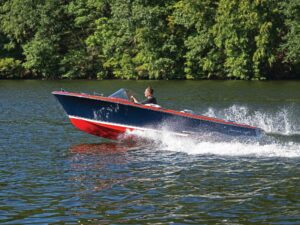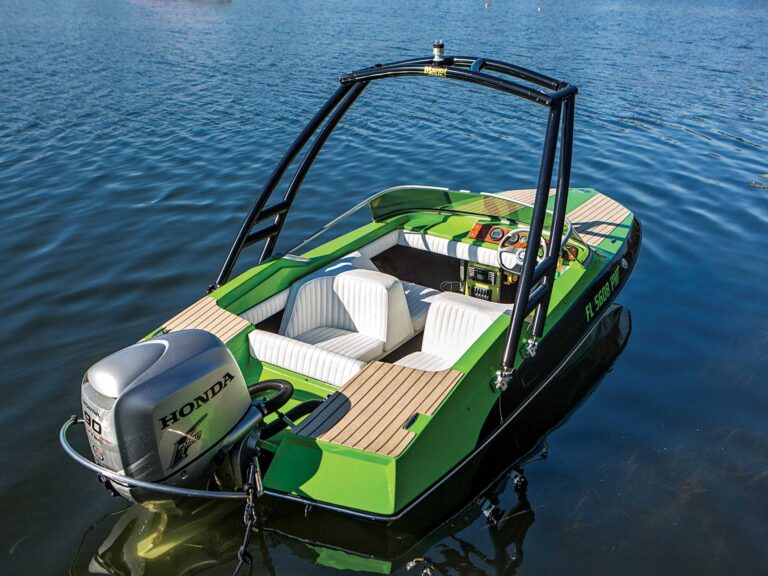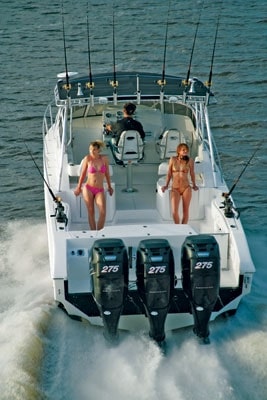
Fountain 38 Sportfish Cruiser Outboard
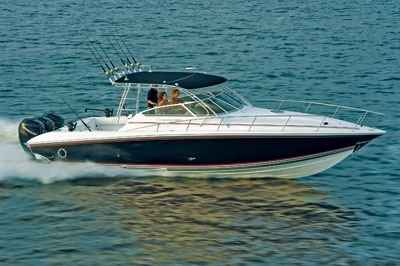
Fountain 38 Sportfish Cruiser Outboard
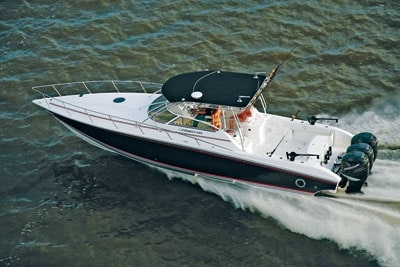
Fountain 38 Sportfish Cruiser Outboard
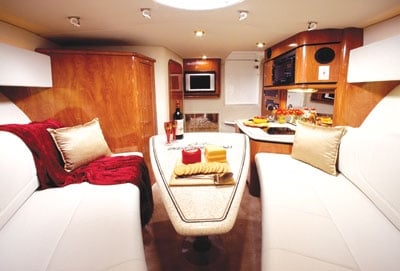
Fountain 38 Sportfish Cruiser Outboard
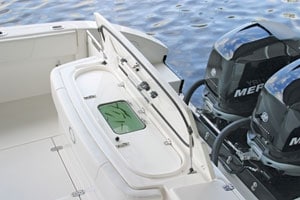
Fountain 38 Sportfish Cruiser Outboard
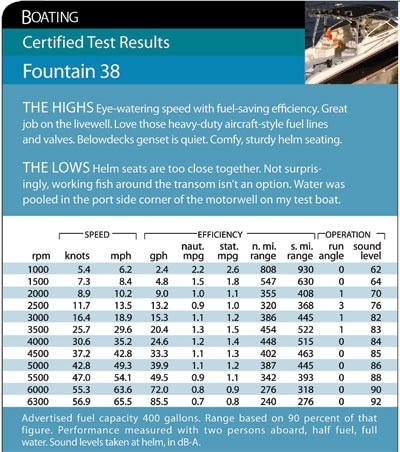
Fountain 38 Sportfish Cruiser Outboard Specs
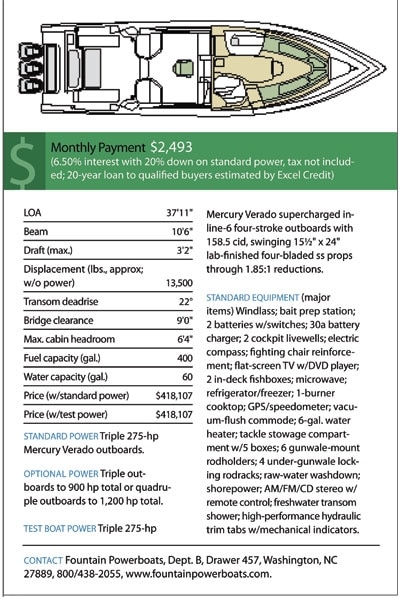
Fountain 38 Sportfish Cruiser Outboard
I’m going to ignite the mayhem – all I have to do is grab those two little handles and quickly push them down. It’ll take little to no effort. And when I do so, I’ll start a series of controlled explosions that unbridles 825 horses and slaps them in the ass. Gasoline will go from liquid to atomized vapor to pure power in a millisecond, and I’ll go from a dead standstill to a full plane in about 2.8 seconds. Before the stopwatch hits 10, I’ll break 50 mph, and in a few more seconds I’ll be going fast enough to earn a $250 speeding ticket on the Jersey Turnpike. It’s a hell of a lot of fun, and I expect no less when jumping into one of Reggie Fountain’s latest creations. But there’s always that hint of guilt, too. Is it right to burn fossil fuel as though it were a renewable resource? To leave a streak of unburned two-cycle oil trailing behind? To scare the fertilizer out of six mallards, two seagulls, and a blowboater? No, no, and oops…too bad. But even though the new 38 Sportfish Cruiser may be throbbing with power, it’s also running on four-stroke engines that make it as efficient as its competitors, if not more so.
Huh? Okay, let’s have it now, one big collective “you gotta be kidding me.” Nope. Cruise this rig at 4500 rpm, and you’ll be running for the fishing grounds at 42.8 mph while burning 33.3 gph. That’s 1.3 mpg. Way better than expected, considering this boat has triple outboards pushing 13,500 pounds of fiberglass loaded with 200 gallons of fuel. In Deep Impact’s 36 ($247,000 with triple 250-hp OptiMax outboards) you’ll achieve 1.1 mpg while running in the mid-40s. On the other hand, the Deep Impact has a slightly higher top end at 65.8 mph. In Sunseeker’s 37 (just over $400,000 with triple 250-hp Yamaha HPDIs) you’ll get only 0.8 mpg in this speed range, and you’ll have to run the mills near 5000 rpm. Of course, the Sunseeker is a much cushier boat, with additional cabin space but less cockpit space.
How can such a screamer run so efficiently? The list of reasons is long but can be boiled down to this: a multitude of hull design tweaks, tested by real-world trial and error. Take the twin steps, for example. Their angle of attack, size, and distance from the center of gravity all have great bearing on their effectiveness. Then throw a planing pad into the mix, in this case an 18″-wide pad with 14 degrees of deadrise, which adds lift along the keel. Consider the chines next, then put in lifting strakes between the pad and the chines. Balance it all out by hanging the motors 26″ aft of the end of the running surface to provide perfect balance. Now jiggle the X dimension, and start testing props. Lots of props. Eventually, after a few decades, if you’re lucky, you get to where Fountain is with the 38 Sportfish Cruiser. In fact, Reggie is completely confident that no competitor can match his boat. After we tried running the boat on two motors to simulate a breakdown-and hit 52 mph doing it-he said, “I defy you to find a boat anywhere in the world of the same length and weight and horsepower that can beat it…and if you can, give me a month and I’ll beat that one, too.”
Cutting-edge hull design is mandatory for this type of performance, but so is lightweight, offshore-grade construction. So the 38 Sportfish Cruiser is built with all vinylester resins, ¾”-thick hullside and deck coring, and all multidirectional glass. The hull-to-deck joint is through-bolted, screwed, and sealed with adhesive/sealant. The baffled 3⁄16″ aluminum fuel tank is foamed and bolted in place. And special care is taken to ensure the mechanical systems are all ready to take on the worst the Atlantic can dish out. Want to see an example for yourself? Pop open the cockpit deck hatch, and look along the port side of the bilge compartment. See those massive high-pressure hoses with the threaded fittings and brass valves? Those are your fuel lines. No cheap rubber that can chafe or get punctured, no plastic oops-I-broke-it fittings, and not a hose clamp in sight.
Uh-huh. So the 38 Sportfish Cruiser is fast and efficient, and it’s built for real-world offshore use. But this is supposed to be a fishboat. Can it hang with the blood-and-guts crowd? If you look at the transom, the first realization is that you’ll never work a fish around those three props. This is a common problem with nearly all modern outboard-powered fishboats, so get over it and move along. The transom livewell is a good one. At 50 gallons, it holds plenty of water, and it has an awesome double hatch more boatbuilders should use: a fiberglass cover hatch with a Plexi hatch below that can be lifted or left in place while you net baits through a smaller, centered access port. Just in case you need to haul goggle eyes and ballyhoo on the same trip, there’s a second livewell aft of the passenger’s seat.
There are two fishboxes in the deck, both of which are large enough to hold 100-pound tuna, smoker kings, or a combination of the two. Built-in tackle stowage is found on the port side up forward in the cockpit, with five tackleboxes built into the back of the helmdeck lounge. Two under-gunwale rodracks per side plus seven hardtop rocket launchers round out the mix.
Zzz’s AND zooms. Maybe you’ve had plenty of fishing time. Maybe all that racing around has you worn out. Whatever – on a boat like this, you expect a place to stretch out and relax, too. The cabin on the 38 Sportfish Cruiser is arranged much like others in this class, with a V-berth/dinette, a kid-size midcabin, a galley, and an enclosed head. The real treat in the comfort category is the helm seating. Although they’re placed too close together (the passenger can’t get to and from his seat without displacing the captain), these are awesome seats, with thick stainless-steel frames, cushy foam padding, and fully adjustable mounts. Hop into one, and put your feet up on the footrest. Yes, that bazooka-size chunk of metal is a footrest – one that will never, ever, ever shake loose, bend, or otherwise fail to fulfill its purpose.
The bridgedeck is large enough to sport two lounges, and on the port side the forward section drops down and folds against the inwale to increase cabin access. That means there’s seating for half a dozen anglers as you punch your way through the seas. But take it from me, even if they’re seated, you’d better tell them to hold on tight before you nail the throttles. And look out for those ducks, will ya?



